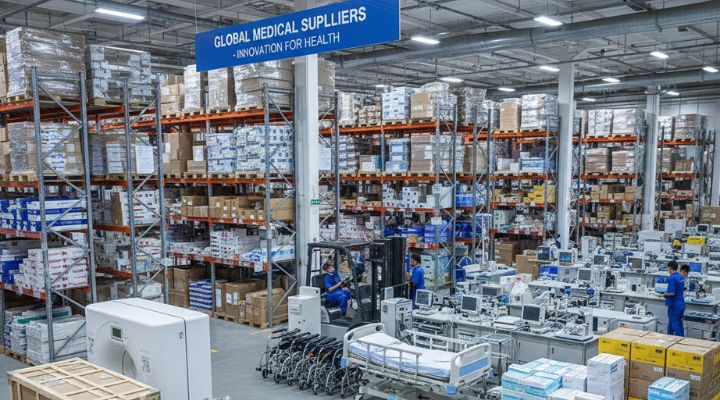
Why Telehealth Benefits Matter: The Hidden Link to At-Home Testing Success
Telehealth benefits are transforming healthcare as we know it, with the global telehealth service market reaching an impressive $83.5 billion in 2022 and projected to grow at a 24% CAGR through 2030. At the same time, the at-home testing market has expanded to $16.66 billion with continued growth expected at 10.5% annually. This parallel rise is no coincidence.
As we face a potential shortage of up to 139,000 physicians by 2033, the significance of these remote healthcare solutions becomes even clearer. In fact, telehealth has proven to be a game-changer for many patients, saving cancer patients approximately $165 per appointment. Additionally, we’ve seen how telemedicine serves as a transformative tool in chronic disease management, particularly for diabetes care.
In this article, we’ll explore why telehealth benefits matter so much in today’s healthcare landscape and how they directly contribute to the success of at-home testing solutions. From cost-effectiveness to improved patient engagement, we’ll uncover the symbiotic relationship between these two healthcare innovations that’s changing how we access and experience medical care.
The healthcare gaps telehealth aims to solve
Healthcare systems nationwide face persistent gaps that limit patient access to quality care. Telehealth has emerged as a powerful solution to address these fundamental challenges.
Cost and access as major barriers
The financial burden of traditional healthcare creates significant obstacles for many patients. Each missed medical appointment costs health systems approximately $260 and can total millions in lost revenue annually. Moreover, these no-shows result in fragmented care, worsening glycemic control, lower preventative screening rates, and increased emergency room visits.
For low-income populations, the barriers are even more pronounced. Patients below the poverty limit are 67% more likely to report transportation-related delays in care. Other common access barriers include:
- Lack of reliable transportation or inability to afford gas and parking fees
- Conflicting work schedules and childcare obligations
- Difficulty securing timely appointments
Nearly one in five appointments in safety-net health systems goes unfulfilled, highlighting how these barriers create substantial care gaps that telehealth can help bridge.
Rural and underserved communities
Despite one in five Americans living in rural areas, these regions face disproportionate healthcare challenges. Over 120 rural hospitals closed in the decade before COVID-19, while only 11% of the physician workforce practices in these communities.
Rural patients often travel an average of 23.5 minutes to reach their primary care provider, with even longer journeys required for specialty care. Consequently, 80% of U.S. counties—home to approximately 30 million people—are classified as healthcare deserts.
The impact is severe: mortality rates in rural healthcare deserts increased by 12% even as overall U.S. mortality decreased. Through telehealth, these communities gain access to previously unavailable specialists and timely care without the burden of travel.
Physician shortages and appointment delays
Long wait times present another significant barrier, with 32.7% of rural survey respondents citing this as their primary obstacle to receiving care. Rural physicians often experience burnout from covering local emergency departments while maintaining their regular practice.
Telehealth helps address these workforce shortages by improving physician recruitment and retention. By connecting patients with providers regardless of location, telehealth effectively expands the available care network while reducing the burden on overextended healthcare professionals.
How COVID-19 accelerated telehealth and at-home testing
The COVID-19 pandemic dramatically altered the healthcare landscape, serving as a catalyst for remote health solutions that had previously struggled to gain widespread adoption.
Pandemic as a turning point
In March 2020, as the first COVID-19 cases spread across the nation, state emergency declarations and stay-at-home orders immediately shifted healthcare delivery priorities. Within a single week, health systems nationwide had to reimagine patient care entirely. Federal regulators swiftly removed longstanding barriers, with the Centers for Medicare and Medicaid Services issuing waivers expanding telehealth coverage and the Office for Civil Rights relaxing HIPAA restrictions to allow platforms like FaceTime and Zoom for patient consultations.
Rapid adoption of virtual care
The statistics reveal an unprecedented transformation. Telehealth visits surged by 154% during the last week of March 2020 compared to the same period in 2019. By April 2020, overall telehealth utilization had skyrocketed to levels 78 times higher than in February. Stanford Healthcare reported providers conducting telehealth consultations at a rate of 3,000 per day—a 50-fold increase over previous months—while Cleveland Clinic’s telehealth visits jumped from 3,400 monthly to 60,000 in March 2020, representing 80% of all patient visits.
Among Medicare beneficiaries alone, telehealth services increased tenfold from approximately 5 million services to over 53 million during the same months in 2020 versus 2019, with spending surging from $306 million to $3.7 billion.
Increased demand for self-monitoring tools
Alongside telehealth growth, at-home testing emerged as a complementary innovation. Since 2022, more than 755 million SARS-CoV-2 antigen self-testing kits have been distributed throughout the United States. The FDA first authorized these tests in late 2020, significantly boosting shipping rates.
Beyond COVID-19 testing, digital self-assessment tools gained traction globally. In France alone, over 13 million self-triage questionnaires were completed during the pandemic’s first eight months. Subsequently, the global at-home testing market reached $7.30 billion in 2023 and is projected to grow at 5.9% annually, reaching $12.30 billion by 2034.
Key benefits of telehealth that support at-home testing
The synergy between telehealth and at-home testing creates a powerful healthcare model that overcomes traditional barriers. Through virtual care integration with home diagnostics Kit, patients experience multiple advantages that enhance their overall health management.
Cost-effectiveness for patients and providers
Telehealth visits cost approximately $79 compared to $146 for traditional in-person consultations, creating substantial savings. For cancer patients, this represents about $165 saved per appointment. Furthermore, telehealth eliminates transportation expenses, with patients saving an average of 2.9 hours in driving time and 1.2 hours in clinic time per visit. These cost reductions particularly benefit patients requiring frequent monitoring for chronic conditions.
Providers also realize financial advantages through:
- Reduced operational expenses from minimized physical infrastructure
- Lower no-show rates, optimizing scheduling and revenue
- Decreased administrative burden and overhead costs
Convenience and flexibility of care
Telehealth’s convenience factor drives improved healthcare access for patients previously limited by travel constraints. Notably, patients can receive timely follow-up care without geographical restrictions, especially beneficial after hospital discharge when rehospitalization risks are highest. This accessibility becomes particularly valuable for the 154 million Americans living with chronic conditions.
Improved patient engagement and follow-through
Virtual healthcare platforms facilitate stronger patient-provider connections. Studies show significantly lower no-show rates with telehealth—between 4.4-7.26% compared to traditional appointment rates of 19-22%. This improved adherence results from eliminating common barriers like transportation difficulties and scheduling conflicts.
Personalized care through biomarker tracking
Telehealth enables continuous health monitoring through digital biomarkers collected via smartphones and wearable devices. This approach provides a comprehensive picture of patients’ day-to-day health status between provider visits. For instance, diabetes management shows remarkable improvements through telehealth, with digital interactions positively correlating with reductions in both HbA1c and weight.
Industry-wide adoption and future potential
The landscape of telehealth adoption has expanded far beyond traditional healthcare settings, creating new opportunities across multiple sectors.
Employers integrating telehealth into benefits
According to recent surveys, nearly all large employers now offer telehealth services, with 97% providing virtual options for acute care. This trend continues to grow, with 69% of employers expected to offer virtual primary care services beyond traditional telehealth by 2027. The appeal for employers is clear—telehealth redirects care from expensive emergency departments, potentially saving between $309 and $1,500 per avoided ER visit.
Startups and innovation in remote diagnostics
The telehealth startup ecosystem is thriving, with 107 companies attracting an aggregate $6.6 billion in funding. These innovators are focusing on areas like AI-powered diagnostics, remote monitoring technologies, and specialized care platforms for underserved populations. Companies like FemTech Health use machine learning to create personalized care plans, while others like Spora Health address healthcare disparities for patients of color.
Decentralized clinical trials and research
Telehealth has become instrumental in decentralized clinical trials (DCTs), enabling research activities to occur remotely. During the pandemic, these approaches emerged as promising solutions to ensure continuity of ongoing studies. Telemedicine supports critical human communication between researchers and participants across all stages of clinical research.
Wearables and data-driven wellness programs
Wearable health technologies are increasingly integrating with telehealth, providing real-time insights for healthcare providers. These devices empower patients by assisting with diagnosis, behavior change, and self-monitoring. In essence, wearables can shift care burdens from health systems to individuals while reducing costs and staff workloads.
Conclusion
As we look toward the future of healthcare, the connection between telehealth and at-home testing stands as a powerful partnership rather than isolated innovations. Together, they address long-standing healthcare challenges while creating new opportunities for patients and providers alike.
Telehealth benefits clearly extend beyond simple convenience. The cost savings for both patients and healthcare systems make essential care accessible to populations previously limited by financial constraints. Additionally, these virtual solutions help bridge critical gaps in rural and underserved communities where healthcare deserts continue to expand.
The COVID-19 pandemic undoubtedly accelerated adoption rates, yet the foundations for this healthcare evolution were already in place. What changed was our collective readiness to embrace these technologies when traditional care models became temporarily unavailable. This widespread acceptance has now solidified into permanent healthcare improvements.
Perhaps most significantly, telehealth creates the perfect environment for at-home testing to thrive. Patients now actively participate in their healthcare journey through continuous biomarker tracking and regular virtual check-ins. This approach transforms the traditional reactive healthcare model into a proactive, personalized experience focused on prevention and early intervention.
The expanding ecosystem of employers, startups, researchers, and wearable technology companies demonstrates how these healthcare innovations will continue evolving. We stand at the beginning of a healthcare transformation that promises to make quality care more equitable, affordable, and effective for everyone.
Telehealth and at-home testing represent more than technological advances—they symbolize a fundamental shift in how we think about healthcare delivery. Their continued integration will almost certainly result in better outcomes, reduced costs, and improved patient experiences across the healthcare spectrum.

 Previous Post
Previous Post Next Post
Next Post

